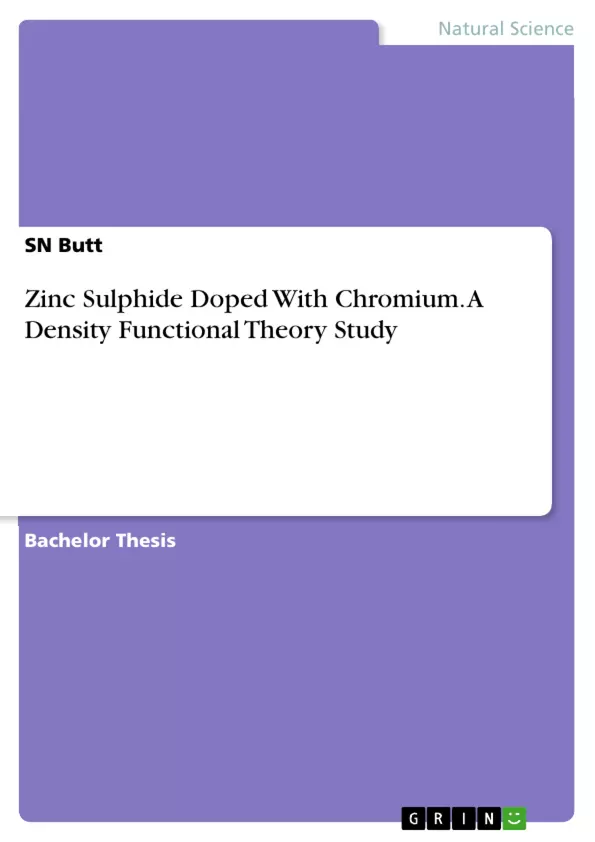In this thesis, the electronic and magnetic properties of Cr doped wurtzite ZnS were studied by means of most advanced theoretical approach density functional theory (DFT) using generalized gradient approximation (GGA) functional and its correction factor GGA+U. Calculations have shown that doping of chromium at cationic sites of wurtzite zinc sulphide results in formation of a p-type semiconductor. Addition of hubbard term in the system causes an increase in band gap value and creates a gap between spin up and spin down channels for 3d states of chromium atoms.
Chromium doped ZnS possess half metallic character because of excess in majority spin carriers than minority ones. Hopping of electrons in anti-bonding states of chromium atoms refers to the ferromagnetic behavior of the material. Half metallicity and ferromagnetic nature of the chromium doped wurtzite zinc sulphide makes this material a best candidate to be used in the field of spintronics.
For the past few decades, work in semiconductor field appears to be of substantial importance in industrial world and offers a new direction to upgrade the standards of life. This novel era of semi-conductors has remake the history of science with its groundbreaking technology and has proven to be an extensively emerging field to handle even single atoms and molecules for manipulation and fabrications. In the recent years, material science has open a new window towards applicability of semiconductor devices in electronics, spintronics and many other branches of science. Presently, II-VI materials have gain much value because of their broad range of applicability in advance fields of science. These elements involve transition metals like zinc, cadmium and nonmetals like oxygen, sulphur, selenium, tellurium. Due to their wide band gap, these compounds possess shorter wavelength and used in optoelectronic devices.
Inhaltsverzeichnis (Table of Contents)
- CHAPTER 01: INTRODUCTION
- 1.1 Research Problem
- 1.2 Research Plan
- CHAPTER 02: LITERATURE REVIEW
- CHAPTER 03: THEORETICAL BACKGROUND
- 3.1 Energy Band Theory.
- 3.2 Semiconductors and their Characteristics
- 3.3 Direct/Indirect Band Gap Semiconductors---
- 3.4 II-VI Compound Semiconductors--
- 3.5 Zinc Sulphide
- 3.6 Exchange Interaction
- 3.6.1 Direct Exchange Interaction
- 3.6.2 Indirect Exchange Interaction
- 3.6.2.1 Double Exchange Interaction
- 3.7 Jahn Teller Effect
- 3.8 Techniques for Computational Study
- 3.9 Density Functional Theory
- 3.9.1 Many-Body Problems in Solids
- 3.9.2 Hohenburg-Kohen Theorems
- 3.9.2.1 First Hohenburg Kohen Theorem
- 3.9.2.2 Second Hohenburg Kohen Theorem
- 3.9.3 Kohan-Sham Equation
- 3.9.4 Exchange Correlational Functional
- 3.9.5 Local Density Approximation (LDA)
- 3.9.6 Local Spin Density Approximation (LSDA)
- 3.9.7 Generalized Gradient Approximation (GGA)
- 3.9.8 LDA and GGA with Hubbard Correction
- 3.9.9 Hybrid Functional
- 3.9.10 Tran-Blah Modified Becke Johnson Potential (TB-mBJ)
- 3.10 Basis Sets
- 3.10.1 Slater-Type Orbital (STO)
- 3.10.2 Gaussian-Type Orbital (GTO) ·
- 3.11 Amsterdam Density Functional (ADF).
- CHAPTER 04: COMPUTATIONAL TECHNIQUES-
- 4.1 ADF-BAND
- 4.2 Brief Introduction to ADF-BAND
- 4.2.1 Features of ADF-BAND
- 4.2.2 Operating System for ADF-BAND
- 4.2.3 Electronic and Structural Parameters using ADF-BAND
- 4.2.4 Construction of wurtzite ZnS structure with ADF-BAND
- 4.2.5 Construction of a unit cell of ZnS
- 4.3 Computational Aspect
- CHAPTER 05: RESULTS AND DISCUSSIONS ·
- 5.1 Electronic Properties
- 5.1.1 Chromium Doped Zinc Sulphide: 16 atoms
- 5.1.2 Cr Doped ZnS: 32 atoms
- 5.1.3 Cr Doped ZnS: 64 atoms
- 5.2 Conclusion
- 5.1 Electronic Properties
Zielsetzung und Themenschwerpunkte (Objectives and Key Themes)
This research investigates the electronic and magnetic properties of chromium-doped wurtzite ZnS using density functional theory (DFT). The primary objective is to understand how doping with chromium affects the material's characteristics and explore its potential applications in spintronics.
- Electronic properties of Cr-doped ZnS
- Magnetic behavior of Cr-doped ZnS
- Impact of doping on band structure and band gap
- Application of DFT and GGA+U methods in materials science
- Potential for Cr-doped ZnS in spintronic devices
Zusammenfassung der Kapitel (Chapter Summaries)
Chapter 1 introduces the research problem and outlines the research plan. It details the motivation behind studying Cr-doped ZnS and explains the methodology used in the investigation. Chapter 2 provides a comprehensive review of existing literature on the subject, analyzing previous research on the properties of ZnS and its potential applications. Chapter 3 delves into the theoretical framework underpinning the study, outlining concepts related to energy band theory, semiconductor characteristics, and computational techniques like density functional theory.
Chapter 4 focuses on the computational methods employed in the research, specifically detailing the use of ADF-BAND software and its capabilities. It discusses the process of constructing a unit cell of ZnS and the various computational aspects of the study. Chapter 5 presents the results and discussions based on the simulations, exploring the electronic properties of Cr-doped ZnS with varying concentrations of chromium. This chapter analyzes the impact of doping on the band structure, spin states, and magnetic properties of the material.
Schlüsselwörter (Keywords)
The central keywords and focus topics of the work are: chromium-doped ZnS, density functional theory, generalized gradient approximation, GGA+U, electronic properties, magnetic properties, band structure, spintronics, half-metallicity, ferromagnetism, computational materials science.
- Quote paper
- SN Butt (Author), 2017, Zinc Sulphide Doped With Chromium. A Density Functional Theory Study, Munich, GRIN Verlag, https://www.grin.com/document/508622



